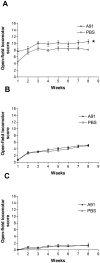Development of protective autoimmunity by immunization with a neural-derived peptide is ineffective in severe spinal cord injury
- PMID: 22348141
- PMCID: PMC3279414
- DOI: 10.1371/journal.pone.0032027
Development of protective autoimmunity by immunization with a neural-derived peptide is ineffective in severe spinal cord injury
Abstract
Protective autoimmunity (PA) is a physiological response to central nervous system trauma that has demonstrated to promote neuroprotection after spinal cord injury (SCI). To reach its beneficial effect, PA should be boosted by immunizing with neural constituents or neural-derived peptides such as A91. Immunizing with A91 has shown to promote neuroprotection after SCI and its use has proven to be feasible in a clinical setting. The broad applications of neural-derived peptides make it important to determine the main features of this anti-A91 response. For this purpose, adult Sprague-Dawley rats were subjected to a spinal cord contusion (SCC; moderate or severe) or a spinal cord transection (SCT; complete or incomplete). Immediately after injury, animals were immunized with PBS or A91. Motor recovery, T cell-specific response against A91 and the levels of IL-4, IFN-γ and brain-derived neurotrophic factor (BDNF) released by A91-specific T (T(A91)) cells were evaluated. Rats with moderate SCC, presented a better motor recovery after A91 immunization. Animals with moderate SCC or incomplete SCT showed significant T cell proliferation against A91 that was characterized chiefly by the predominant production of IL-4 and the release of BDNF. In contrast, immunization with A91 did not promote a better motor recovery in animals with severe SCC or complete SCT. In fact, T cell proliferation against A91 was diminished in these animals. The present results suggest that the effective development of PA and, consequently, the beneficial effects of immunizing with A91 significantly depend on the severity of SCI. This could mainly be attributed to the lack of T(A91) cells which predominantly showed to have a Th2 phenotype capable of producing BDNF, further promoting neuroprotection.
Conflict of interest statement
Figures





Similar articles
-
Long-term production of BDNF and NT-3 induced by A91-immunization after spinal cord injury.BMC Neurosci. 2016 Jun 30;17(1):42. doi: 10.1186/s12868-016-0267-6. BMC Neurosci. 2016. PMID: 27364353 Free PMC article.
-
Prophylactic neuroprotection with A91 improves the outcome of spinal cord injured rats.Neurosci Lett. 2013 Oct 25;554:59-63. doi: 10.1016/j.neulet.2013.08.048. Epub 2013 Sep 5. Neurosci Lett. 2013. PMID: 24012811
-
The Severity of Spinal Cord Injury Determines the Inflammatory Gene Expression Pattern after Immunization with Neural-Derived Peptides.J Mol Neurosci. 2018 Jun;65(2):190-195. doi: 10.1007/s12031-018-1077-3. Epub 2018 May 23. J Mol Neurosci. 2018. PMID: 29796836
-
T cell-based therapeutic vaccination for spinal cord injury.Prog Brain Res. 2002;137:401-6. doi: 10.1016/s0079-6123(02)37031-6. Prog Brain Res. 2002. PMID: 12440382 Review.
-
Immunomodulation induced by central nervous system-related peptides as a therapeutic strategy for neurodegenerative disorders.Pharmacol Res Perspect. 2021 Oct;9(5):e00795. doi: 10.1002/prp2.795. Pharmacol Res Perspect. 2021. PMID: 34609083 Free PMC article. Review.
Cited by
-
Long-term production of BDNF and NT-3 induced by A91-immunization after spinal cord injury.BMC Neurosci. 2016 Jun 30;17(1):42. doi: 10.1186/s12868-016-0267-6. BMC Neurosci. 2016. PMID: 27364353 Free PMC article.
-
Autoimmunity in acute ischemic stroke and the role of blood-brain barrier: the dark side or the light one?Front Med. 2019 Aug;13(4):420-426. doi: 10.1007/s11684-019-0688-6. Epub 2019 Mar 30. Front Med. 2019. PMID: 30929189 Review.
-
Use of a combination strategy to improve neuroprotection and neuroregeneration in a rat model of acute spinal cord injury.Neural Regen Res. 2019 Jun;14(6):1060-1068. doi: 10.4103/1673-5374.250627. Neural Regen Res. 2019. PMID: 30762019 Free PMC article.
-
Active and Passive Immunization with Myelin Basic Protein as a Method for Early Treatment of Traumatic Spinal Cord Injury; a Meta-Analysis.Arch Acad Emerg Med. 2021 Aug 30;9(1):e57. doi: 10.22037/aaem.v9i1.1316. eCollection 2021. Arch Acad Emerg Med. 2021. PMID: 34580655 Free PMC article. Review.
-
Use of Cells, Supplements, and Peptides as Therapeutic Strategies for Modulating Inflammation after Spinal Cord Injury: An Update.Int J Mol Sci. 2023 Sep 11;24(18):13946. doi: 10.3390/ijms241813946. Int J Mol Sci. 2023. PMID: 37762251 Free PMC article. Review.
References
-
- Bakalash S, Kipnis J, Yoles E, Schwartz M. Resistance of retinal ganglion cells to an increase in intraocular pressure is immune-dependent. Invest Ophthalmol Vis Sci. 2002;43:2648–2653. - PubMed
-
- Ibarra A, Hauben E, Butovsky O, Schwartz M. The therapeutic window after spinal cord injury can accommodate T cell-based vaccination and methylprednisolone in rats. Eur J Neurosci. 2004;19:2984–2990. - PubMed
Publication types
MeSH terms
Substances
LinkOut - more resources
Full Text Sources
Medical
Research Materials

